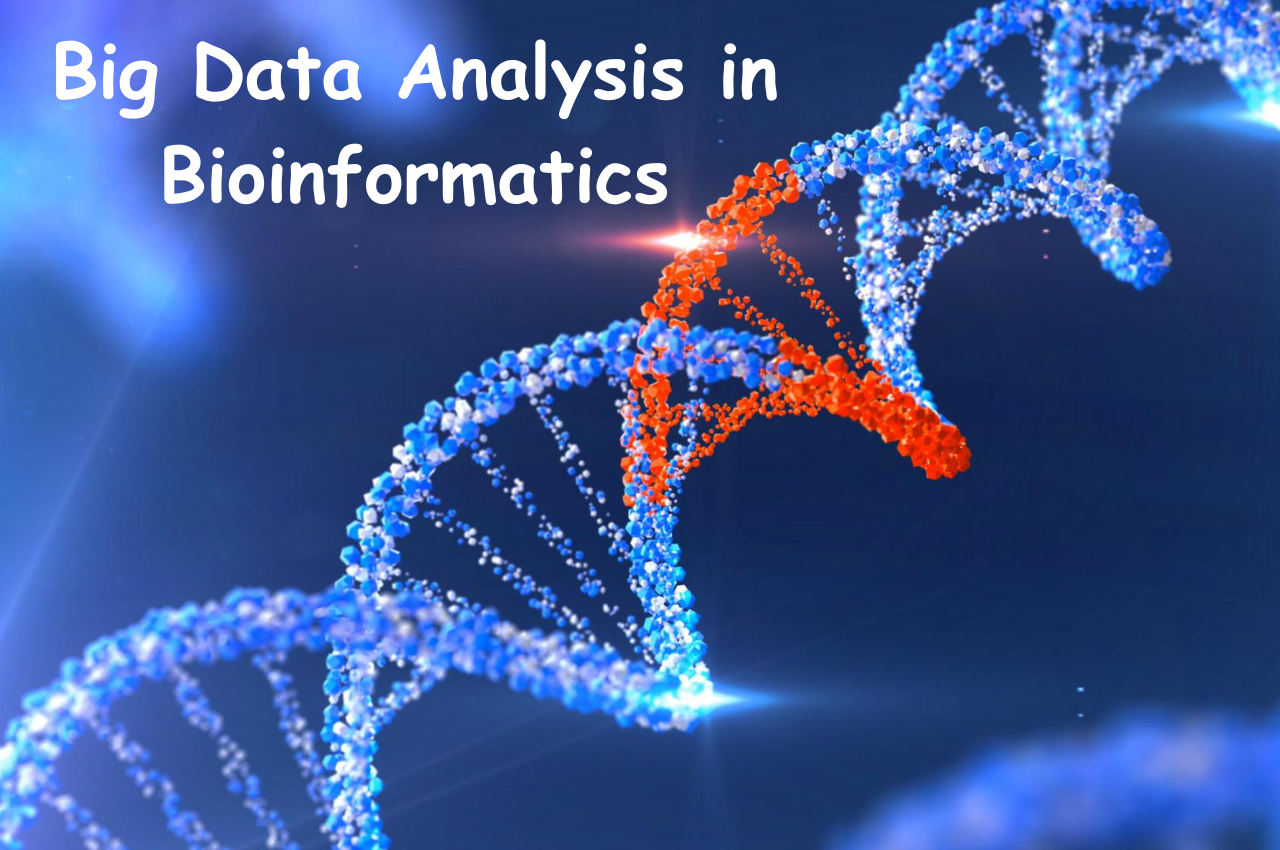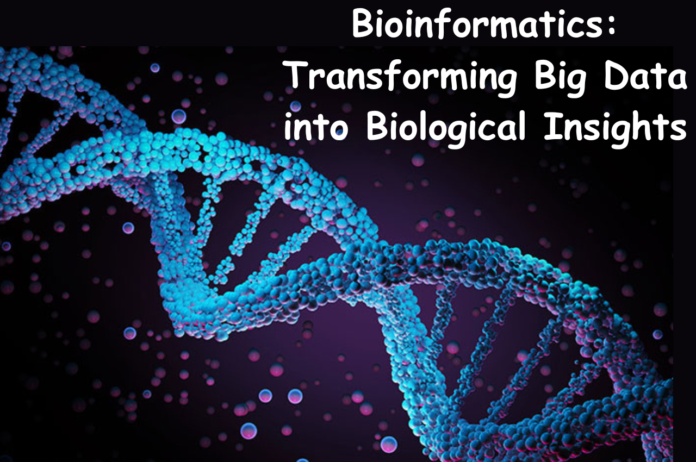Bioinformatics is an interdisciplinary domain that “turns big data into biological insights”, combining biology, computer science, mathematics, and statistics to validate and interpret biological data. It specifically focuses on extensive datasets produced by advanced technologies like genomics, transcriptomics, proteomics, and metabolomics. These datasets, commonly known as “big data” in the realm of biology, encompass a wealth of information pertaining to genes, proteins, metabolic pathways, and various other biological molecules. In this article, we will delve into the intricacies of converting vast biological datasets into valuable biological insights.
Thank you for reading this post, don't forget to subscribe!Introduction
The rise of data in the contemporary age has brought about a surge in the volume and intricacy of biological data due to the emergence of new terminologies, methods, and high-throughput technologies in various fields of study. Among these, big data and bioinformatics have emerged as key areas of focus, offering both opportunities and challenges for researchers seeking to comprehend the intricate processes governing life. Bioinformatics, an interdisciplinary field merging biology with computational science, plays a crucial role in decoding these vast datasets and extracting meaningful biological insights.
Embarking on a journey into the realm of bioinformatics, we explore how the fusion of advanced computational techniques and biological expertise is reshaping the landscape of biological research. Through the utilization of computational algorithms, statistical analysis, and machine learning approaches, researchers are delving into the intricacies of genomics, transcriptomics, proteomics, and more. The exponential expansion of biological data poses a significant challenge: how to navigate through extensive data to identify patterns, pinpoint biomarkers, and unravel the enigmas of complex biological systems. Nevertheless, this challenge also presents immense opportunities. The fusion of big data analytics with biological research holds the potential to revolutionize our understanding of fundamental biological processes, ranging from the molecular mechanisms underlying diseases to the evolutionary dynamics shaping biodiversity.
In this series, we will delve into the methodologies, tools, and applications propelling the conversion of big data into biological insights. From genome sequencing and gene expression profiling to protein structure prediction and drug discovery, bioinformatics equips researchers with the ability to navigate the complexities of biological systems with unparalleled precision and efficiency. Join us on this thrilling journey into the realm of bioinformatics.
What is Big Data in Bioinformatics?
The field of bioinformatics deals with “transforming big data into biological insights” derived from various high-throughput techniques such as next-generation sequencing, microarray analysis, mass spectrometry, and imaging technologies. This data encompasses genomic sequences, gene expression profiles, protein structures, metabolic pathways, and clinical information. The volume and complexity of biological data have grown significantly in recent years due to technological advancements and reduced data generation costs.
The utilization of big data in bioinformatics enables researchers to comprehensively explore intricate biological systems and uncover patterns, associations, and relationships that were previously hidden. It aids in the identification of new biomarkers for disease diagnosis, prognosis, and treatment. Big data analytics play a crucial role in pinpointing potential drug targets and supporting drug discovery and development efforts. Moreover, it facilitates the implementation of personalized medicine by integrating genomic, clinical, and other pertinent data to customize treatments for individual patients. These initiatives are geared towards leveraging the power of big data in bioinformatics to enhance our understanding of biology, enhance healthcare outcomes, and expedite biomedical research.
How can bioinformatics be helpful in biological research?
Bioinformatics is a vital component of biological research as it employs computational techniques to examine extensive biological data. The utilization of bioinformatics tools aids in the analysis of DNA, RNA, and protein sequences. These tools encompass sequence alignment, the identification of homologous sequences, and the prediction of protein structure and function based on sequence data. Moreover, bioinformatics is instrumental in the assembly and annotation of genomes, thereby assisting researchers in comprehending the structure, function, and evolution of genomes across various species. By comparing genomes from different organisms, researchers can discern similarities and disparities, investigate evolutionary relationships, and uncover genes associated with specific traits or diseases.
Furthermore, bioinformatics tools facilitate the prediction and analysis of the three-dimensional structures of protein and RNA molecules, which are pivotal for comprehending their functions and interactions. These methods are employed to construct phylogenetic trees, illustrating the evolutionary relationships between different species or groups of organisms based on molecular data. Additionally, bioinformatics aids in the analysis of gene expression data, the identification of regulatory elements such as promoters and enhancers, and the comprehension of gene regulatory networks. These tools empower researchers to analyze intricate microbial communities, enabling the identification of the diverse range of microorganisms present in a given sample.
Bioinformatics plays a vital role in the amalgamation of data from various sources to create models and simulate biological systems. This enables us to gain a deeper understanding of intricate biological processes at a systems level. These powerful tools are instrumental in conducting virtual screenings of potential drug candidates, predicting interactions between drugs and targets, and comprehending mechanisms of drug resistance. Moreover, bioinformatics is indispensable for analyzing genomic and clinical data, allowing for tailored treatments and personalized interventions for individual patients, ultimately leading to more effective healthcare. In essence, bioinformatics acts as a crucial link between biological information and knowledge, expediting discoveries and advancements in diverse areas of biological research.
Challenges in Handling Big Biological Data
Handling large-scale biological data presents numerous challenges due to the immense size, intricate nature, and diverse characteristics of the data involved. Some of the primary challenges include:
1. Data Volume: Biological data, such as genomic sequences, protein structures, and gene expression profiles, can reach massive sizes. For instance, sequencing technologies can generate terabytes of data in a single experiment, overwhelming traditional data storage and processing systems.
2. Data Quality and Accuracy: Biological data often contains noise and errors due to limitations in experimental techniques and biological variability. Ensuring data quality and accuracy through cleaning and preprocessing is crucial but can be particularly challenging, especially when dealing with large datasets.
3. Data Privacy and Security: Biological data frequently contains sensitive information about individuals, such as genomic data. Balancing data privacy and security while enabling data sharing and collaboration among researchers requires careful consideration of ethical and legal frameworks.
4. Data Analysis and Interpretation: Extracting meaningful insights from vast biological datasets necessitates the use of advanced computational and statistical methods. Developing and implementing these methods for large-scale data analysis is a complex and continuously evolving research area.
5. Reproducibility and Replicability: Ensuring the reproducibility and replicability of analyses conducted on large biological datasets is crucial for the progress of scientific research. However, achieving reproducibility can be challenging due to the complexity of data analysis pipelines and the dynamic nature of biological data.
Overall, addressing these challenges is essential for effectively harnessing the potential of big biological data and advancing scientific knowledge in various fields.
Big Data Analysis in Bioinformatics
Big data analysis in bioinformatics utilizes computational techniques to process, analyze, and interpret large volumes of biological data. Bioinformatics combines biology, computer science, statistics, and mathematics to tackle complex biological questions through data-driven methods. Genomics focuses on an organism’s complete DNA set, encompassing genes and non-coding sequences. High-throughput sequencing technologies like next-generation sequencing enable the rapid generation of vast amounts of genomic data. Bioinformatics tools are essential for analyzing genomic data to explore gene expression, genetic variation, evolutionary relationships, and more.  Transcriptomics delves into an organism’s complete RNA transcripts, including mRNA, non-coding RNA, and small regulatory RNAs. Analysis of transcriptomic data involves tasks like differential gene expression analysis, alternative splicing analysis, and functional annotation of transcripts. Proteomics involves the extensive study of proteins, encompassing their structures, functions, and interactions. Mass spectrometry-based proteomics produces large datasets of protein sequences and abundances. Bioinformatics tools play a crucial role in protein identification, quantification, post-translational modification analysis, and prediction of protein-protein interactions. Metabolomics entails the thorough analysis of small molecules (metabolites) present in biological samples. Mass spectrometry and nuclear magnetic resonance spectroscopy are commonly used techniques for generating metabolomic data. Bioinformatics tools aid in metabolite identification, metabolic pathway analysis, and biomarker discovery.
Transcriptomics delves into an organism’s complete RNA transcripts, including mRNA, non-coding RNA, and small regulatory RNAs. Analysis of transcriptomic data involves tasks like differential gene expression analysis, alternative splicing analysis, and functional annotation of transcripts. Proteomics involves the extensive study of proteins, encompassing their structures, functions, and interactions. Mass spectrometry-based proteomics produces large datasets of protein sequences and abundances. Bioinformatics tools play a crucial role in protein identification, quantification, post-translational modification analysis, and prediction of protein-protein interactions. Metabolomics entails the thorough analysis of small molecules (metabolites) present in biological samples. Mass spectrometry and nuclear magnetic resonance spectroscopy are commonly used techniques for generating metabolomic data. Bioinformatics tools aid in metabolite identification, metabolic pathway analysis, and biomarker discovery.
Structural biology delves into the 3D configurations of biological molecules, like proteins and nucleic acids. Techniques like X-ray crystallography, nuclear magnetic resonance (NMR) spectroscopy, and cryo-electron microscopy (cryo-EM) are employed to gather structural information. Bioinformatics tools play a key role in tasks such as protein structure prediction, molecular docking, and structure-function analysis. The integration of diverse biological data from various origins is a critical component of bioinformatics research. Bioinformatics platforms and databases offer resources for data management, integration, and retrieval. Data visualization methods, including heatmaps, networks, and interactive plots, assist in understanding and presenting intricate biological datasets.
Bottom Line
In summary, the incorporation of big data analytics in bioinformatics has transformed the landscape of biological research. By utilizing advanced algorithms and computational tools, scientists can now delve into extensive genomic, proteomic, and metabolomic data to unveil hidden patterns, pinpoint biomarkers, and gain valuable insights into intricate biological processes. A major benefit of big data analytics in bioinformatics is its capacity to expedite scientific breakthroughs. Through processing and scrutinizing data on a large scale, researchers can swiftly pinpoint significant correlations and trends that would otherwise remain undetected using conventional methods. This swift analysis has paved the way for advancements in areas like personalized medicine, drug discovery, and disease diagnosis.
Nonetheless, the integration of big data analytics in bioinformatics also brings forth various challenges. The management and analysis of massive datasets necessitate substantial computational resources and expertise. Furthermore, ensuring the accuracy and reliability of data is essential for obtaining precise outcomes. Moreover, ethical concerns such as data privacy and security must be meticulously addressed to safeguard sensitive information.
Technocommy is a connecting space, the leading growth and networking organization for business owners and leaders. Do I qualify?


